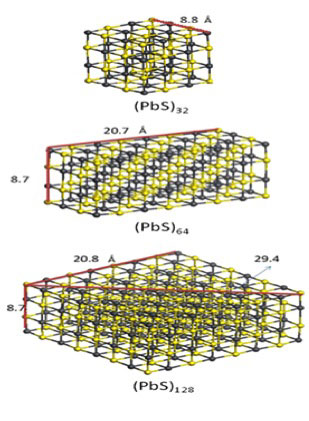| Apr 18, 2012 |
Baby crystal discovery big step for nanoscience
|
|
(Nanowerk News) How small can a chemical compound be and still retain the properties of that same compound in bulk? With computer models and laboratory experiments, researchers at Johns Hopkins University, collaborating with those at McNeese State University in Lake Charles, LA, and the University of Konstanz in Germany, have determined the smallest crystal configuration, or as they call it, a "baby crystal," of lead sulfide (see paper in Journal of Chemical Physics: "(PbS)32: A baby crystal").
|
|
The team first determined the structure theoretically with computer modeling. They then proved their model experimentally in the laboratory by carefully depositing clusters of (PbS)32 onto a graphite surface, where the clusters could migrate together into larger nanoscale units.
|
 |
| Predicted dimensions of nano-blocks achieved by growing individual (PbS)32 baby crystals. STM images confirmed these dimensions. (Illustration courtesy Bowen Lab)
|
|
"By using scanning tunneling microscope (STM) images to measure the dimensions of the resultant lead sulfide nano-blocks, we confirmed that (PbS)32 baby crystals had indeed stacked together as predicted by theory," said Kit Bowen Jr., the E. Emmet Reid Professor in the Department of Chemistry at Johns Hopkins. Bowen worked on the project with, Howard Fairbrother, also a professor of chemistry. Both are affiliated faculty members of the Institute for NanoBioTechnology.
|
|
Bowen explained that the baby crystal needed just 32 units of lead sulfide to "exhibit the same structural coordination properties" of the same material at macroscale. Nanoblocks this small would have photovoltaic (solar power) applications.
|
|
"Determining the size of nano and sub-nano scale assemblies of atoms or molecules at which they first take-on recognizable properties of the same substance in the macroscopic world is an important goal in nanoscience," Bowen said.
|
|
Their research can be found in the Journal of Chemical Physics and The Virtual Journal of Nanoscale Science & Technology. A Department of Energy grant funded this research.
|

